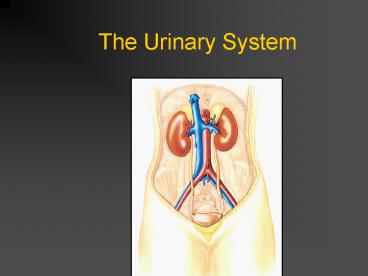The Urinary System - PowerPoint PPT Presentation
1 / 44
Title:
The Urinary System
Description:
The Urinary System Kidneys as Filters Maintaining Chemical Homeostasis The Urinary System General Functioning of the Kidney Nitrogenous Wastes Organs of the Urinary ... – PowerPoint PPT presentation
Number of Views:112
Avg rating:3.0/5.0
Title: The Urinary System
1
The Urinary System
2
Function
- Remove nitrogenous wastes
- Maintain electrolyte, acid-base, and fluid
balance of blood - Homeostatic organ
- Acts as blood filter
- Release hormones calcitriol erythropoietin
3
Kidneys as Filters
- Diuretic- loose water coffee, alcohol
- Antidiuretic- retain water ADH
- Aldosterone- sodium water reabsorption, and K
excretion - GFR 180 liters (50 gal) of blood/day
- 178-179 liters are reabsorbed back into blood
- Excrete a protein free filtrate
4
(No Transcript)
5
Maintaining Chemical Homeostasis
6
The Urinary System
7
General Functioning of the Kidney
urine
refreshed blood
8
Nitrogenous Wastes
urea
uric acid
ammonia
9
Organs of the Urinary System
10
Kidney Anatomy
11
Kidney Anatomy
12
Nephron Functioning
urine
refreshed blood
13
(No Transcript)
14
Each kidney contains over 1 million nephrons and
thousands of collecting ducts
DCT
Glomerulus
PCT
Collecting duct
Loop of Henle
15
Glomerular Filtration
Filters blood proteins cant pass through
16
Composition of Glomerular Filtrate
- Water
- Small Soluble Organic Molecules
- Mineral Ions
17
Proximal Convoluted Tubule
Reabsorbs water, glucose, amino acids, and
sodium.
- 65 of Na is reabsorbed
- 65 of H2O is reabsorbed
- 90 of filtered bicarbonate (HCO3-)
- 50 of Cl- and K
18
Loop of Henle
Creates a gradient of increasing sodium ion
concentration towards the end of the loop within
the interstitial fluid of the renal pyramid.
- 25 Na is reabsorbed in the loop
- 15 water is reabsorbed in the loop
- 40 K is reabsorbed in the loop
19
Distal Convoluted Tubule
Under the influence of the hormone aldosterone,
reabsorbs sodium and secretes potassium. Also
regulates pH by secreting hydrogen ion when pH of
the plasma is low.
- only 10 of the filtered NaCl and 20 of water
remains
20
Collecting Duct
Allows for the osmotic reabsorption of water.
ADH (antidiuretic hormone)- makes collecting
ducts more permeable to water-- produce
concentrated urine
21
Urine
- Water- 95
- Nitrogenous waste
- urea
- uric acid
- creatinine
- Ions
- sodium
- potassium
- sulfate
- phosphate
From the original 1800 g NaCl, only 10 g appears
in the urine
22
Hormonal Control of Kidney Function
23
Hormonal Control of Kidney Function
high plasma solute concentration
low blood volume
24
Hormonal Control of Kidney Function
hypothalamus
25
Hormonal Control of Kidney Function
26
Hormonal Control of Kidney Function
reduced blood pressure and glomerular filtrate
27
Hormonal Control of Kidney Function
renin
28
Hormonal Control of Kidney Function
angiotensin II
29
Urinary Bladder
30
Bladder
- Mucosa (transitional epithelium)
- Muscular layer (detrusor muscle) 3 layers of
smooth muscle - Fibrous adventia
31
Sphincter Muscles on Bladder
- Internal urethral sphincter
- Smooth muscle
- Involuntary control
- More superiorly located
- External Urethral sphincter
- Skeletal muscle
- Voluntary control
- Posteriorly located
32
Diuresis (Micturition)
When bladder fills with 200 ml of urine, stretch
receptors transmit impulses to the CNS and
produce a reflex contraction of the bladder (PNS)
When is incontinence normal?
33
Distension of the Urinary Bladder
34
Urinalysis
Why do doctors ask for a urine sample?
- characteristics
- smell- ammonia-like
- pH- 4.5-8, ave 6.0
- specific gravity more than 1.0 1.001-1.003
- color- affected by what we eat salty foods,
vitamins
35
Odor
odor- normal is ammonia-like diabetes mellitus-
smells fruity or acetone like due to elevated
ketone levels diabetes insupidus-
yucky asparagus---
36
pH- range 4.5-8 ave 6.0 vegetarian diet- urine
is alkaline protein rich and wheat diet- urine
is acidic
37
Color
Color- pigment is urochrome Yellow color due to
metabolic breakdown of hemoglobin (by bile or
bile pigments) Beets or rhubarb- might give a
urine pink or smoky color Vitamins- vitamin C-
bright yellow Infection- cloudy
38
Specific Gravity
Water s.g. 1g/liter Urine s.g. 1.001 to
1.030
Pyelonephritus- urine has high s.g. form kidney
stones Diabetes insipidus- urine has low s.g.
drinks excessive water injury or tumor in
pituitary
39
Abnormal Constitutes of Urine
- Glucose- when present in urine condition called
glycosuria (nonpathological) glucose not
normally found in urine - Indicative of
- Excessive carbohydrate intake
- Stress
- Diabetes mellitus
40
Abnormal Constitutes of Urine
Albumin-abnormal in urine its a very large
molecule, too large to pass through glomerular
membrane gt abnormal increase in permeability of
membrane Albuminuria- nonpathological conditions-
excessive exertion, pregnancy, overabundant
protein intake-- leads to physiologic
albuminuria Pathological condition- kidney trauma
due to blows, heavy metals, bacterial toxin
41
Abnormal Constitutes of Urine
Ketone bodies- normal in urine but in small
amts Ketonuria- find during starvation, using fat
stores Ketonuria is couples w/a finding of
glycosuria-- which is usually diagnosed as
diabetes mellitus RBC-hematuria Hemoglobin- Hemogl
obinuria- due to fragmentation or hemolysis of
RBC conditions hemolytic anemia, transfusion
reaction, burns or renal disease
42
Abnormal Constitutes of Urine
Bile pigments- Bilirubinuria (bile pigment in
urine)- liver pathology such as hepatitis or
cirrhosis WBC- Pyuria- urinary tract infection
indicates inflammation of urinary tract Casts-
hardened cell fragments, cylindrical, flushed out
of urinary tract WBC casts- pyelonephritus RBC
casts- glomerulonephritus Fatty casts- renal
damage
43
INQUIRY
- List several functions of the kidneys.
- What does the glomerulus do?
- What are several constitutes you should not find
in urine? - What is specific gravity?
- What two hormones effect fluid volume and sodium
concentration in the urine? - Where are the pyramids located in the kidney?
- What vessel directs blood into the glomerulus?
- Where does most selective reabsorption occur in
the nephron?
44
Moment of Zen
KIDNEY































